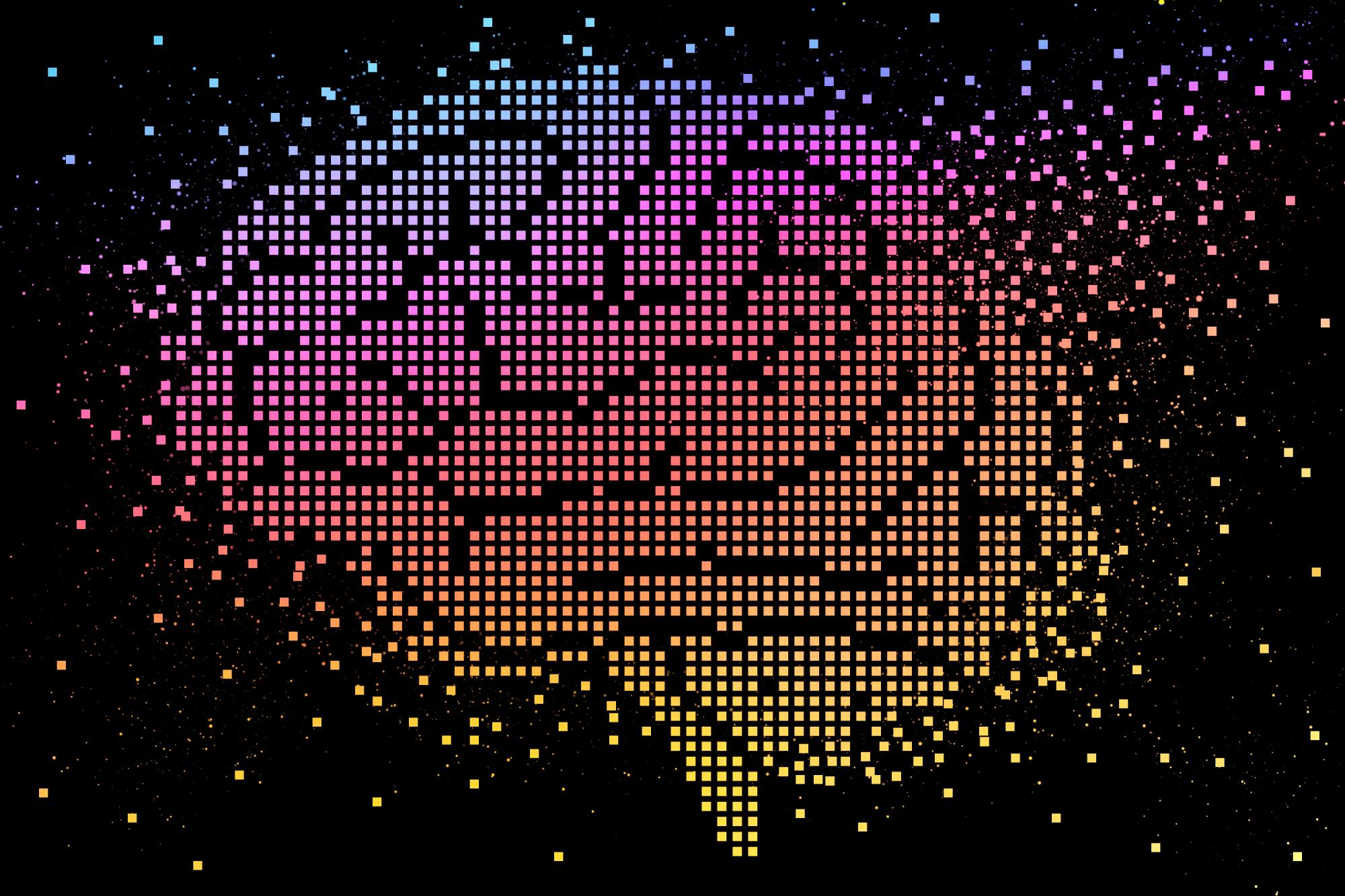
- Share via
The fantasy began to consume me at the turn of the millennium.
I’d always felt like a half-being, a cyborg of incompatible substances: gringa daughter of a Puerto Rican MD and a long-unemployed Mexican man with addiction issues. Native or alien. Nerd or rebel. I was white and not white but thought I had to choose.
No wonder, then, that the greatest ambition of my youth was to achieve digital immortality, or uploading my mind to the metaverse. Goodbye, flawed body. Hello, god-self.
Opinion Columnist
Jean Guerrero
Jean Guerrero is the author, most recently, of “Hatemonger: Stephen Miller, Donald Trump and the White Nationalist Agenda.”
A playful interaction with my father in the 1990s had primed me. He was showing me the Macintosh Plus, our first computer: a beige box with a rainbow apple logo. Papi guided my hands over the keyboard, causing me to poke one letter of my name at a time until there I was in the box: j-e-a-n. He clicked “file,” “save,” “X,” and my name disappeared. It frightened me. Papi turned off the computer, ignoring my protests. “Watch,” he said. He powered it back on and clicked through folders. Suddenly, there I was again, resurrected: j-e-a-n.
Inside the apple box, I could live forever.
The fantasy’s premise, which I’d contemplate in later years, was that I was reducible to code: 0s and 1s. This view of life and data as interchangeable spread long before social media.
At USC in 1988, two philosophy students launched the journal Extropy. The opposite concept, entropy, is a law of physics: The universe tends toward chaos. Extropians saw this disorder as the “supreme enemy.” Their journal, whose contributors were overwhelmingly white and male, nurtured a cult of technology-worshiping immortality seekers.
They were early transhumanists, the pseudo-intellectual offspring of eugenicists, with their hubristic quest to breed a master race and all of its consequent horrors: from the Holocaust to the forced sterilization of tens of thousands of people, mostly women of color and others labeled “defective.” Eugenicists thought there was such a thing as a perfect body; transhumanists went a step further to say perfection lay in select minds, which could transcend bodies altogether.
Transhumanists preach that a command of technology can liberate humans from the limits of mortal flesh. Human destiny is to leave our puny Earth and colonize the stars. Extropians argued that this agenda required rejecting morality, which could interfere with the rapid expansion of technologies that might, oops, destroy the Earth. (No biggie when the goal is infinity!)
In the early ’90s, Wired magazine glamorized the Extropian cultists as hard-partying, psychonautic intellectuals. Slowly, transhumanism grew into a global movement now trending with some of the world’s most powerful people, including the richest, Elon Musk. Its twin cult is “longtermism,” which says we should prioritize “positively impacting” humanity in the faraway future: not just in the next few generations, but thousands or millions of generations from today. That philosophy also has Musk’s support and that of others such as Facebook co-founder Dustin Moskovitz and cryptocurrency billionaire Sam Bankman-Fried, a top Biden donor.
Ultimately, this isn’t about biological humans. The father of longtermism, Nick Bostrom, a transhumanist and Oxford philosophy professor, has been trying to push into the mainstream the idea that the future’s hypothetical digital people matter more than the billions of humans alive today because there will be at least 1058 of them. That’s a 1 followed by 58 zeroes — the number of human simulations he calculates we could run using the stars’ computing power.
The New York Times, the New Yorker and other media have given longtermism fawning coverage this year with little or no mention of its deranged core. The global fad and media frenzy are almost understandable at this moment in history. It truly is hard to watch: climate change, war, migration crises, economic instability, political regression into nativism, fascism and dictatorships. It’s not science fiction but current events that inspire the quest for an escape path from planet Earth.
Longtermism is often framed as a way to protect Earth. But its architects care less about ecosystems than about making sure nothing stops humanity from reaching what Bostrom calls “technological maturity.” That’s a nice way of characterizing that moment when people turn into bits.
Last year, Émile P. Torres, a philosopher who studies existential threats and has extensively investigated longtermism, warned that the traction longtermism is gaining makes it “the most dangerous secular belief system in the world today.”
Leading longtermists have arrived at abhorrent conclusions, such as that philanthropy should focus on saving and improving wealthy people’s lives more than poor people’s because that’s a more direct way to ensure the innovation needed to launch us into space.
Douglas Rushkoff, author of “Survival of the Richest: Escape Fantasies of the Tech Billionaires,” argues that the only way to reduce carbon emissions and salvage the Earth is to reduce consumption. “Longtermism is a way for [tech giants] to justify not looking back at the devastation they’re leaving in their wake,” he told me. “It’s a way for them to say it doesn’t matter all the damage I’m doing now because it’s for a future where humans will be in the galaxies.”
Whether it’s Musk’s plan to colonize Mars or Mark Zuckerberg’s promise of a Metaverse, these billionaires’ visions of escape via more industrial tools, more mass-produced technologies, can be seductive. At least Icarus’ hubris cost only his own life.
As a preteen, I’d never heard of the transhumanists, the longtermists or the Extropians. But their early members were pumping propaganda into the culture, including the possibility of escaping our human forms, which they depicted as “weak, vulnerable, stupid.” This perspective infected me at a time when I was frightened of my body — of its origins and its uncertain future.
The chaos and doom that Extropians and their heirs saw in the Earth and its mortal vessels, I sensed in myself. Years later, when I heard Musk talking on a podcast about human bodies as hideous sacks of meat that we must ditch for robot encasements, I remembered my teen self and the pain I harbored. The tech supremacists promised a clean escape. I wanted one.
I thought I couldn’t possibly matter as much as what those men might make out of me.
::
In the early 2000s, I spent hundreds of hours trying to upload my mind to the web. I’d sit at our computer in the evenings — by this time a stylish blue iMac G3 — and type every detail I could recall of the past 24 hours into a blog. I believed if I captured enough of my thoughts and experiences online, eventually some kindly engineer, long after my death, might revive me in the form of an algorithm. I’d be immortal.
It was a teen girl’s techno-futurist fantasy, a twist on the Snow White fairy tale. I imagined nature as the poisoned fruit; the engineer was my savior. But the real poison was the fantasy.
For years, I was reckless with my body. I swallowed dangerous pills and pursued relationships with violent men. There were highs in all of that. Like the transhumanists, I came to believe that humans contain value only insofar as they experience pleasure, high intellect and other properties as defined by thinkers almost exclusively white and male.
For a time, I suspected I’d inherited something from my father, who abandoned us amid a deluge of his own abnormal thoughts that my mother called “schizophrenia.” In studying neuroscience at USC, I caught a glimpse of myself in “The Divided Self,” a psychiatry classic. In it, R.D. Laing argues that the root of mental illness lies in mind-body dualism, which splits self from others. “[The] body is felt as the core of a false self, which a detached, disembodied, ‘inner,’ ‘true’ self looks on at … a divorce of self from body deprives the unembodied self from direct participation in any aspect of the life of the world.”
I was watching myself as I maneuvered my body toward risks. I wasn’t her. I was the mind.
Or so I thought. That escape from the self and the present is the false promise of longtermism. It was never true.
My journey to regain my sense of my body was long and circuitous. I was diagnosed with post-traumatic stress disorder in my 20s after a near-death experience in a drug cartel zone that I was touring for adrenaline. I developed an autoimmune condition in my 30s. My body, by revolting against my abuse, guided me back to it.
Other people, by caring about me in the depths of my self-destruction, taught me empathy for my embodied self: yes, I am a “mind,” but I am also belly, blood, wrinkled palms. I’m as much a writer as I am the woman who dances on longboards. I’m the books I’ve written and I’m my heritage of bad hombres. Native and alien. Nerd and rebel.
“Human beings can maintain ambiguity over time,” Rushkoff told me. “They can hold onto contradiction. Machines can’t do that. Machines resolve. It’s this versus that. Whatever is uniquely human is in that in-between space they can’t record.”
The spark of human consciousness can’t be uploaded in 0s and 1s. It can, however, be studied.
The Brain and Creativity Institute at USC is using brain scans and other tools to demonstrate that feelings sprout from the soil of our bodies and are central to consciousness.
“It’s really extraordinary that something that for so long was considered sort of peripheral to our lives — feeling — is in fact the very beginning, the foundation, the inaugural event of what becomes consciousness,” said Antonio Damasio, an international leader in neuroscience who runs the institute with his wife, Hanna Damasio, an expert in brain imaging.
In his acclaimed book “Descartes’ Error,” he challenges French philosopher René Descartes’ famous saying, “I think, therefore I am.” It’s more like I feel, therefore I am.
Our minds can conceptualize a self only because they’re receiving input from the rest of the body, through hormones, heartbeats, gurgling guts.
That’s why transhumanism’s ideal of freeing the self from the body will never be achievable, and why longtermism’s story of uploading future generations will remain just science fiction. Our minds are inseparable from the meat of us, with its unsolvable mysteries.
I sympathize with the desire to think otherwise. That siren song of immortality once lulled me into reckless risks, and I was lucky to survive. Now it’s spreading on a larger scale.
Mars and Metaverse are not the future. We must save the one planet that we have. It’s the source of our miraculous bodies, which are far greater than any machine.
More to Read
A cure for the common opinion
Get thought-provoking perspectives with our weekly newsletter.
You may occasionally receive promotional content from the Los Angeles Times.












